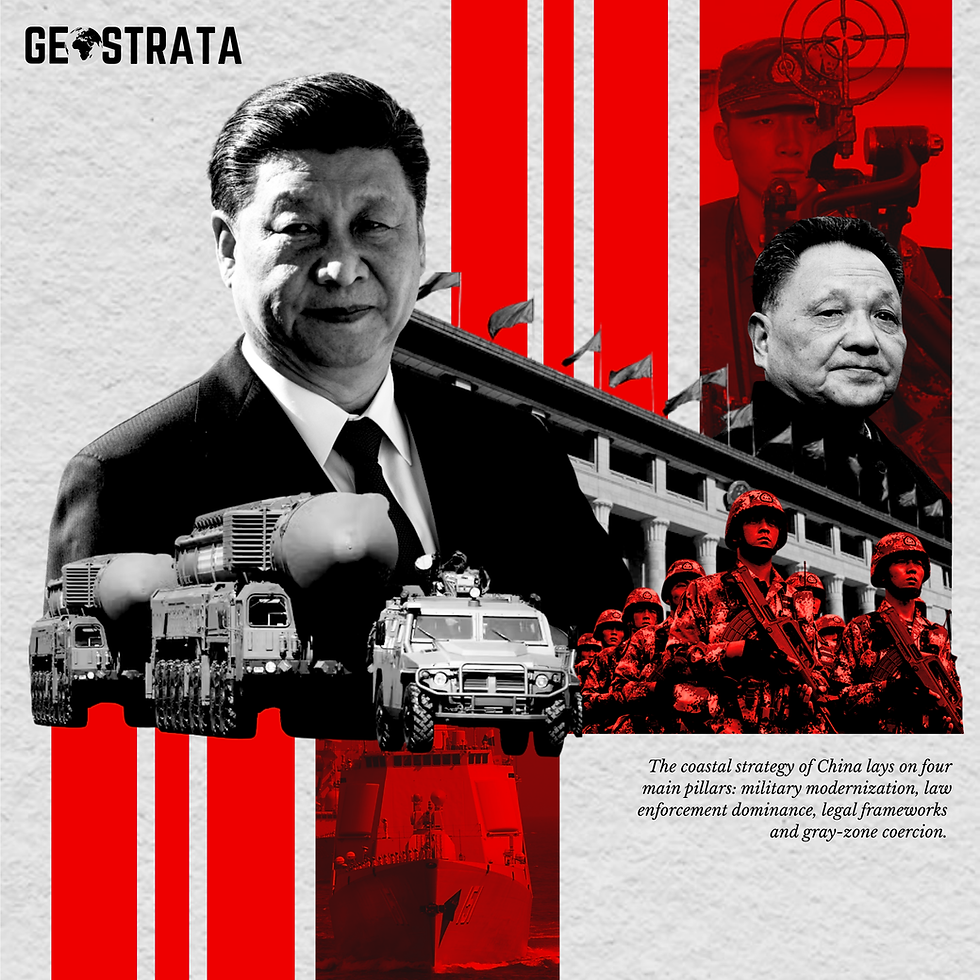China’s Coastal Security: Analysing Maritime Dominance
- THE GEOSTRATA

- 1 day ago
- 4 min read
The People's Republic of China, founded in 1949, has always had a thirst for power and dominance. In the beginning, while it was protecting and conquering lands, it left the coasts unguarded. A brutal mistake to commit.
Illustration by The Geostrata
It was only in the late 1970s that Deng Xiaoping's reforms transformed the coast into China’s economic engine. Exports and the presence of ports tied China’s survival to maritime security. Yet, by the 1990s, clashes in the South China Sea revealed the need for modernisation. The Gulf War, watched closely, convinced the Chinese leaders that naval dominance was indeed required for national and international power.
THE PRESENT LANDSCAPE
Today, China commands one of the largest navies and coast guards in the world. With over 130,000 personnel, sailing alongside naval fleets with more than 370 battle-force ships, maritime militias disguised as fishing boats shadow foreign vessels and infrastructure: ports, telecom cables serve both commerce and deference.
The coastal strategy of China lays on four main pillars: military modernization, law enforcement dominance, legal frameworks and gray-zone coercion.
A central component is China’s Anti-Access/Area Denial (A2/AD) system, designed to deter the operations of U.S. and allied forces near its maritime boundary. Its deployment of ballistic missiles, DF-21D and DF-26, is essential for targeting networks. Beyond this, China has also built militarised artificial islands in the South China Sea, such as Mischief Reefs. They serve as unsinkable aircraft carriers, and these make China’s coastal area a forward-operating base for power-projection.
The China Coast Guard operates under military command structures, and its significance lies not only in size but also in its legal and operational mandate. The 2021 Coast Guard Law expanded the powers of the Guard, granting them explicit authority to use force against vessels in water claimed by China. They engage in patrols, escorts, and blockades; however, these actions fall into a grey zone of military aggression and complications in international responses.
Similarly, Beijing claims some portions of the International Maritime Law, such as that of the UNCLOS, while rejecting adverse rulings of the Permanent Court of Arbitration in 2016, as it invalidated China’s nine-dash claim in the South China Sea.
Combined with coast guards, it portrays a grey zone: placing militia at the front line, coast guard for law enforcement, and the navy over the horizon as deterrence. This three-tiered approach allows China to press its claims aggressively without escalating to open conflict.
SOUTH CHINA SEA CHESSBOARD
The South China Sea is the board where Beijing plays most aggressively. In 2012, China established control over the sea, following a standoff with the Philippines. Since then, it has maintained a persistent presence. Recently, it has decided to designate the shoal as a “nature reserve”, highlighting China’s strategy of bureaucratic entrenchment.
Nearly 1/3rd of global shipping passes through these waters; beneath its seabed lie significant reserves of oil, and the fisheries sustain millions across Southeast Asia.
For China, controlling this space secures trade routes, energy supplies and a buffer against naval presence of enemy nations.
The chessboard is not uncontested. Just like the Philippines has granted access to more U.S. forces to utilise the waters, Vietnam continues to resist China’s advances while strengthening its own coast guard. The South China Sea has become a central arena where the larger struggle over the Indo-Pacific is being played out.
THE INDIAN OCEAN DILEMMA
While the South China Sea remains Beijing’s immediate focus, the Indian Ocean is its vulnerable artery. China has invested heavily in alternative routes for its exports and imports, and satellite images in 2025 show increased Chinese naval visits to East African and Middle Eastern ports. This expansion alarms India, which sees encirclement around its own neighbourhood.
While India has expanded its deployments to the Andaman and Nicobar Islands, and maritime exercises with Australia, Japan, and the USA have increased. The Indian Ocean thus becomes a zone of silent competition where China’s need for security collides with India’s fear of strategic intrusion.
The “string of pearls”, which ranges from Gwadar port in Pakistan to Hambantota in Sri Lanka, serves for commercial and military purposes.
Though China claims these are for trade, the dual-use nature of ports imply that Chinese warships can refuel, extending their operational reach. India is potentially being encircled, thus strengthening its own naval defence and QUAD ties.
TECHNOLOGY WARFARE
Chinese firms are deploying unmanned surface vessels and underwater drones for both reconnaissance and potential mine warfare. Artificial Intelligence integration by smart commands now fuses data from satellites, drones, and ships, giving commanders a real-time picture of coastal zones. In 2022, the Chinese PLA Navy launched the first AI Drone carrier, an unmanned ship named Zhu Hai Yun.
Yet, dependencies on technology could later lead to cyber disruption and electronic warfare. Through this, a strengthened technology has now become imperative for China in the race for maritime dominance.
GLOBAL REACTIONS
No strategy exists in isolation. China’s coastal posture has triggered responses across the globe. The US conducts regular freedom of navigation operations in the South China Sea, often sailing destroyers within sight of Chinese outposts. Though these missions are carried out in the name of international law, the real purpose lies to Chinese forces that their A2/AD is not a deterrent for them.
The Philippines, once faced with setbacks, has now granted the US forces access to its bases. Similarly, Australia and Japan have also deepened their QUAD and naval exercises in the Pacific region. The European Union has labelled freedom of navigation a vital interest linking maritime security in Asia to global trade.
WAY FORWARD
While China’s coastal strategy is a shield to protect its prosperity, it also implies global influence, enabling Beijing’s showcase of power beyond its shores. Whether the coastal frontier is a visible domination of power, it would further trigger conflict and shape the Indo-Pacific order for the decades to come. The seas that once fueled China’s rise to power may also expose its greatest vulnerability, making coastal security not just a matter of national defence but an arena where China’s ambitions of power are reflected.
BY JIANA JAIN
TEAM GEOSTRATA
.png)








Comments